Innovative Use of UHPC and Topology Optimization in Permeable Interlocking Pavers: Advancing Sustainable Pavement Solutions
Abstract
1. Introduction
2. Research Scope and Significance
3. Literature Review
4. Materials and Methods
4.1. Seep-Sink-Block Design—Numerical Optimization
- Geometric modeling: A three-dimensional model of a standard block (200 × 100 × 60 mm) was initially designed using ANSYS SpaceClaim (Version R2 2024), adhering to standard block geometry. A quarter-symmetry approach was adopted to reduce computational effort.
- Material assignment: the geometry was imported into ANSYS Workbench (Version R2 2024), where linear elastic, isotropic, uncracked, and homogeneous material properties were assigned based on the parameters listed in Table 1.
- Finite element discretization: The model was discretized using the finite element method (FEM) with a structured hexahedral mesh (Figure 2). A high-order 20-node SOLID186 element formulation was employed to ensure numerical accuracy and convergence in the mechanical response analysis.
- Boundary conditions and loading configuration:
4.2. Experimental Validation
4.2.1. Materials and Mix Design
4.2.2. Casting
4.2.3. Mechanical Performance
Compressive Strength
Dynamic Modulus of Elasticity
5. Results and Discussion
5.1. Seep-Sink-Block Design—Numerical Optimization
5.2. Experimental Validation
5.2.1. Mix Design
5.2.2. Casting
5.2.3. Mechanical Performance
Compressive Strength
Dynamic Modulus of Elasticity
6. Conclusions
Author Contributions
Funding
Institutional Review Board Statement
Informed Consent Statement
Data Availability Statement
Conflicts of Interest
Abbreviations
| UHPC | Ultra-High-Performance Concrete |
| FEA | Finite Element Analysis |
| OPC | Ordinary Cement Portland |
| ABNT | Associação Brasileira de Normas Técnicas |
| NBR | Norma Brasileira |
| TO | Topology Optimization |
| CAD | Computer-Aided Design |
| CAE | Computer-Aided Engineering |
| SF | Silica Fume |
| LF1 | Limestone Filler 1 |
| LF5 | Limestone Filler 5 |
| DfM | Design for Manufacturing |
| MC | Microcement |
| SSA | Specific Surface Area |
| LOI | Loss On Ignition |
| ASTM | American Society for Testing and Materials |
| ICPI | Interlocking Concrete Pavement Institute |
| DOF | Degree Of Freedom |
| GHG | Greenhouse Gas |
References
- Barua, P.; Saha, A.K. Climate Change Impact on Migration Situation in Coastal Delta Belt of Bangladesh: A Qualitative Explorative Study. J. Clim. Change 2024, 10, 51–68. [Google Scholar] [CrossRef]
- Federal Highway Administration (FHWA). Highway Statistics Series; U.S. Department of Transportation: Washington, DC, USA, 2011. Available online: http://www.fhwa.dot.gov (accessed on 12 August 2024).
- Xie, N.; Akin, M.; Shi, X. Permeable Concrete Pavements: A Review of Environmental Benefits and Durability. J. Clean. Prod. 2019, 210, 1605–1621. [Google Scholar] [CrossRef]
- Kia, A.; Wong, H.S.; Cheeseman, C.R. High-Strength Clogging Resistant Permeable Pavement. Int. J. Pavement Eng. 2021, 22, 271–282. [Google Scholar] [CrossRef]
- Kia, A. Permeable Concrete Pavements for a Climate Change Resilient Built Environment. Adapt. Built Environ. Clim. Change 2023, 15, 297–326. [Google Scholar] [CrossRef]
- Foster, J.; Lowe, A.; Winkelman, S. The Value of Green Infrastructure for Urban Climate Adaptation; Center for Clean Air Policy: Washington, DC, USA, 2011. [Google Scholar]
- Jamshidi, A.; Kurumisawa, K.; White, G.; Nishizawa, T.; Igarashi, T.; Nawa, T.; Mao, J. State-of-the-Art of Interlocking Concrete Block Pavement Technology in Japan as a Post-Modern Pavement. Constr. Build. Mater. 2019, 200, 713–755. [Google Scholar] [CrossRef]
- Haselbach, L.M.; Batezini, R.; Dutra, V.; Schwetz, P.; Filho, L.C.P.S.; Curvo, F.; Balbo, J.T. Nondestructive Method for Estimating Porosity of In-Situ Pervious Concrete. J. Test. Eval. 2016, 45, 1726–1735. [Google Scholar] [CrossRef]
- Kevern, J.; Schaefer, V.R.; Wang, K. Mixture Proportion Development and Performance Evaluation of Pervious Concrete for Overlay Applications. ACI Mater. J. 2011, 108, 439–448. [Google Scholar]
- Schaefer, V.R.; Wang, K.; Muhannad, T.S.; Kevern, J.T. Mix Design Development for Pervious Concrete in Cold Climates; Final Report, Iowa State University: Ames, IA, USA, 2006. [Google Scholar]
- Interlocking Concrete Pavement Institute (ICPI). Permeable Interlocking Concrete Pavements: Selection, Design, Construction and Maintenance, 3rd ed.; Interlocking Concrete Pavement Institute (ICPI): Burlington, NJ, USA, 2006. [Google Scholar]
- Pioch, S.; Relini, G.; Souche, J.C.; Stive, M.J.F.; De Monbrison, D.; Nassif, S.; Simard, F.; Allemand, D.; Saussol, P.; Spieler, R.; et al. Enhancing eco-engineering of coastal infrastructure with eco-design: Moving from mitigation to integration. Ecol. Eng. 2018, 120, 574–584. [Google Scholar] [CrossRef]
- Zhu, J.-H.; Zhang, W.-H.; Xia, L. Topology optimization in aircraft and aerospace structures design. Arch. Comput. Methods Eng. 2016, 23, 595–622. [Google Scholar] [CrossRef]
- Silva, C.O. Sistema de Piso com Peças de Concreto [Livro Eletrônico]: Pavimento Intertravado-Manual de Desempenho, 1st ed.; Associação Brasileira de Cimento Portland (ABCP); Associação Brasileira da Indústria de Blocos de Concreto-BlocoBrasil: São Paulo, Brazil, 2022. [Google Scholar]
- Oliveira, F.H.; Picelli, R.; Silva, E.C.; Barari, A.; Romano, R.C.; Pileggi, R.G.; Tsuzuki, M.S. Topology Optimization in 3D Concrete Printing to Reduce Greenhouse Gas Emissions. IFAC-PapersOnLine 2024, 58, 634–639. [Google Scholar] [CrossRef]
- Azmee, N.M.; Shafiq, N. Ultra-High Performance Concrete: From Fundamental to Applications. Case Stud. Constr. Mater. 2018, 9, e00197. [Google Scholar] [CrossRef]
- Gu, C.; Ye, G.; Sun, W. Ultrahigh Performance Concrete-Properties, Applications and Perspectives. Sci. China Technol. Sci. 2015, 58, 587–599. [Google Scholar] [CrossRef]
- Bahmani, H.; Mostofinejad, D. Microstructure of Ultra-High-Performance Concrete (UHPC)–A Review Study. J. Build. Eng. 2022, 50, 104118. [Google Scholar] [CrossRef]
- Belgard Architectural Products Group. High Heel Shoes & Belgard® Permeable Pavers. 2018. Available online: https://www.belgardcommercial.com/wp-content/uploads/2023/10/Belgard-Technical-Note-High-Heel-Shoes-and-Belgard-Permeable-Pavers.pdf (accessed on 21 April 2025).
- ABNT NBR 16416:2015; Pervious Concrete Pavement—Requirements and Procedures. Associação Brasileira de Normas Técnicas: Rio de Janeiro, Brazil, 2015.
- Timoshenko, S.; Goodier, J.N. Theory of Elasticity, 2nd ed.; McGraw-Hill: New York, NY, USA, 1951. [Google Scholar]
- ABNT NBR 9781:2013; Concrete Paving Units—Specification and Test Methods. Associação Brasileira de Normas Técnicas: Rio de Janeiro, Brazil, 2013.
- Mesquita, J.A.F.S. Ultra-high Performance Concrete (UHPC) eco-efficient: Strategies to minimize mixing energy and binder consumption. Master’s Dissertation, Polytechnic School of the University of São Paulo, Department of Civil Construction Engineering, São Paulo, Brazil, 2024; 168p. [Google Scholar]
- Maciel, M.H.; Soares, G.S.; de Oliveira Romano, R.C.; Cincotto, M.A. Monitoring of Portland cement chemical reaction and quantification of the hydrated products by XRD and TG in function of the stoppage hydration technique. J. Therm. Anal. Calorim. 2019, 136, 1269–1284. [Google Scholar] [CrossRef]
- Mantellato, S.; Palacios, M.; Flatt, R.J. Relating early hydration, specific surface and flow loss of cement pastes. Mater. Struct. 2019, 52, 5. [Google Scholar] [CrossRef]
- Sealey, B. Silica fume for high performance concrete. In Proceedings of the Uluslararası 10. Beton Kongresi, 3rd Session, 46th Term Proceedings, Istanbul, Turkey, 2–4 May 2019. [Google Scholar]
- Romano, R.C.O.; Schreurs, H.; John, V.M.; Pileggi, R.G. Influência da técnica de dispersão nas propriedades de sílica ativa. Cerâmica 2008, 54, 456–461. [Google Scholar] [CrossRef]
- Zain, M.; Safiuddin, M.; Mahmud, H. Development of high performance concrete using silica fume at relatively high water–binder ratios. Cem. Concr. Res. 2000, 30, 1501–1505. [Google Scholar] [CrossRef]
- Westman, A.E.R.; Hugill, H.R. The Packing of Particles. J. Am. Ceram. Soc. 1930, 13, 767–779. [Google Scholar] [CrossRef]
- ASTM C109; Standard Test Method for Compressive Strength of Hydraulic Cement Mortars (Using 2-in. or [50-mm] Cube Specimens). ASTM International: West Conshohocken, PA, USA, 2020.
- ABNT NBR 8802:2019; Hardened Concrete—Determination of Ultrasonic Wave Transmission Velocity. Associação Brasileira de Normas Técnicas: Rio de Janeiro, Brazil, 2019.
- ASTM C597; Standard Test Method for Ultrasonic Pulse Velocity Through Concrete. ASTM International: West Conshohocken, PA, USA, 2023.
- Ibrahim, A.; Mahmood, A.H.; Hamid, R.; Taha, M.R. Experimental and analytical study on properties of pervious concrete for pavement applications. Constr. Build. Mater. 2014, 50, 524–529. [Google Scholar] [CrossRef]
- Lian, C.; Zhuge, Y. Optimum mix design of enhanced permeable concrete–An experimental investigation. Constr. Build. Mater. 2010, 24, 2664–2671. [Google Scholar] [CrossRef]
- Tennis, P.D.; Leming, M.L.; Akers, D.J. Pervious Concrete Pavements; PCA Serial No. 2828; Portland Cement Association (PCA): Washington, DC, USA, 2004; Available online: https://www.cement.org (accessed on 21 August 2024).
- Silva, M.F.; Gomes, A.C.; Rodrigues, J.P. Recycled materials in paving blocks: Sustainable solutions for the construction industry. Constr. Build. Mater. 2020, 247, 118539. [Google Scholar] [CrossRef]
- de Camargo, M.V. Evaluation of the Permeability and Elastic Modulus of Concretes with Different Fine-Aggregate Contents. Master’s Thesis, Universidade Estadual de Maringá, Maringá, Brazil, 2018. Available online: https://pcv.uem.br/documentos/dissertacao-de-mestrado/dissertacao_marcos-vinicio-de-camargo_entrega-1.pdf (accessed on 18 April 2025).
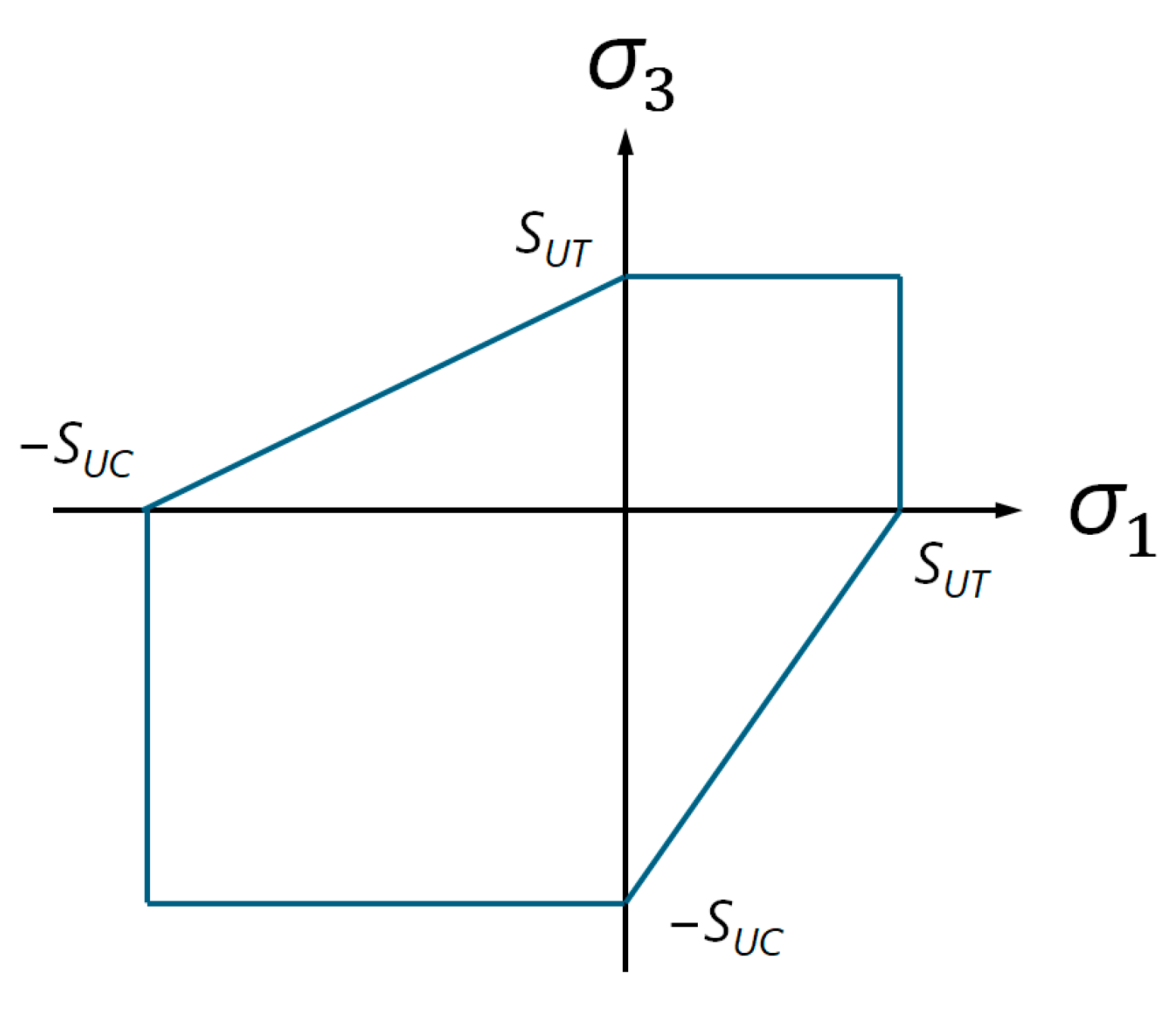
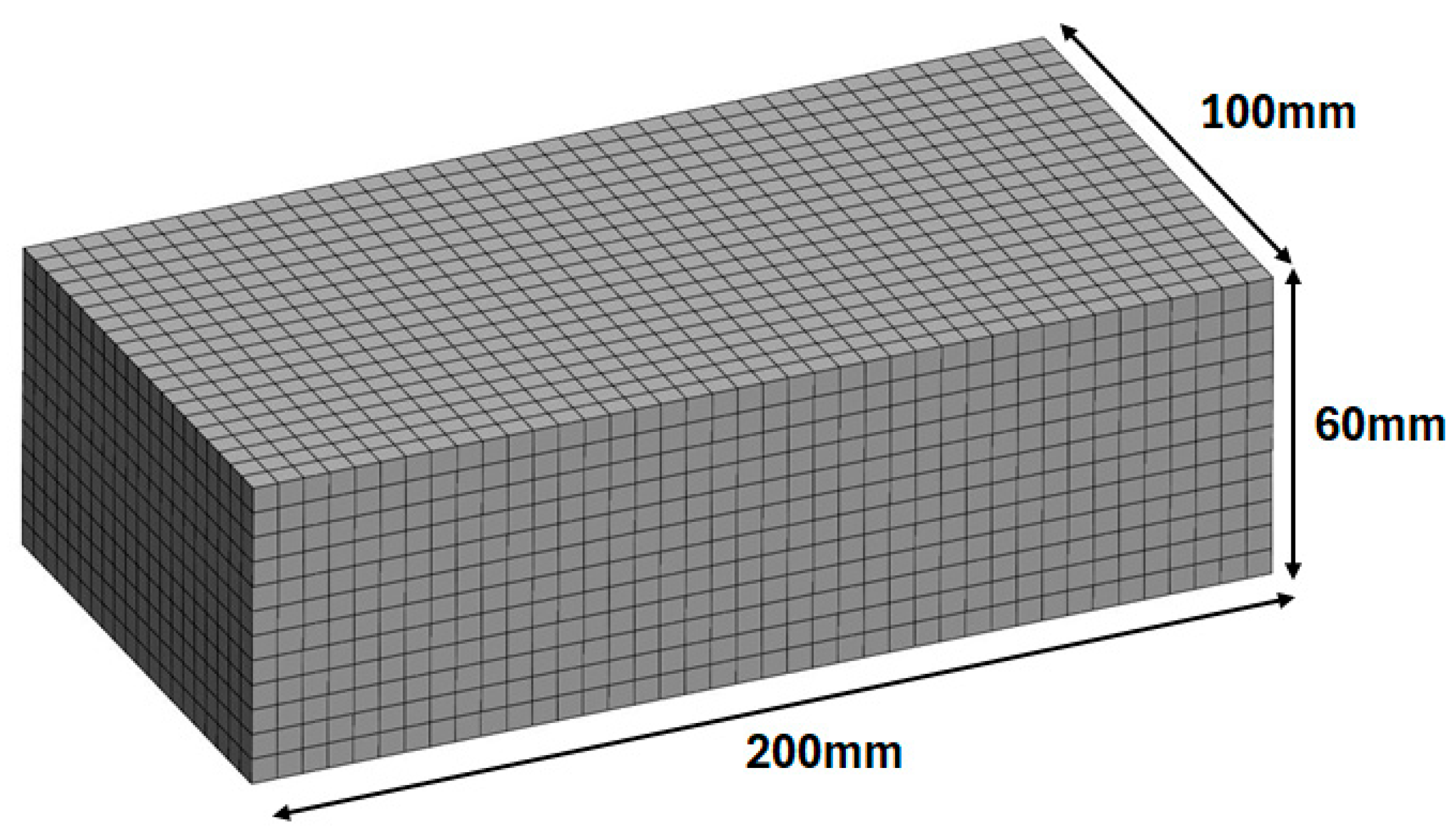
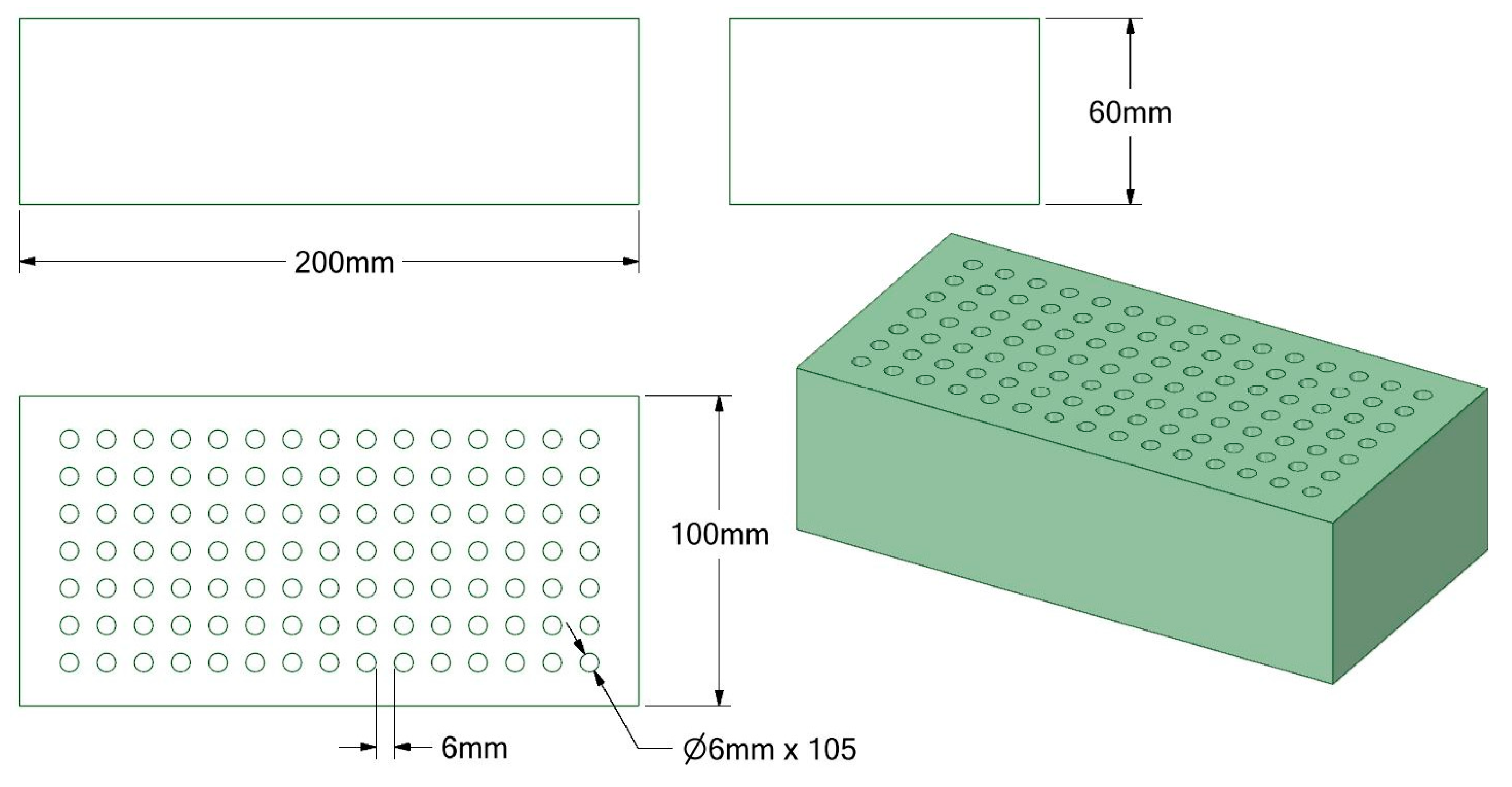

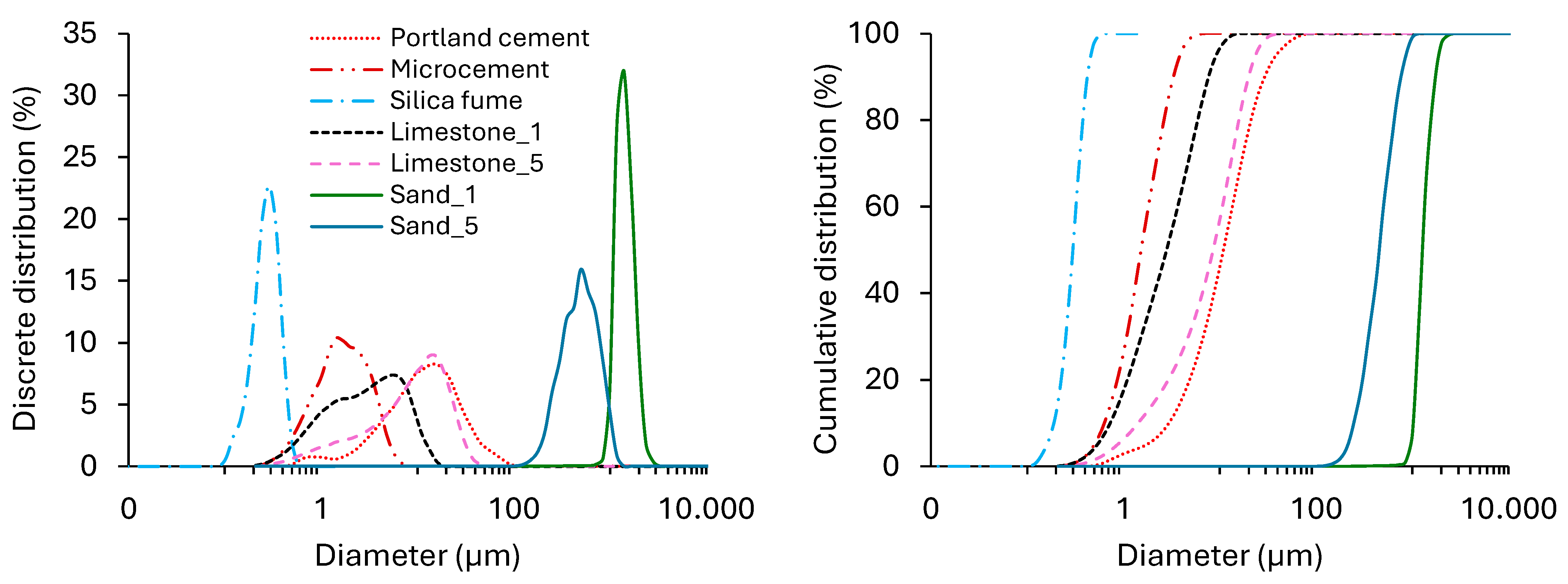
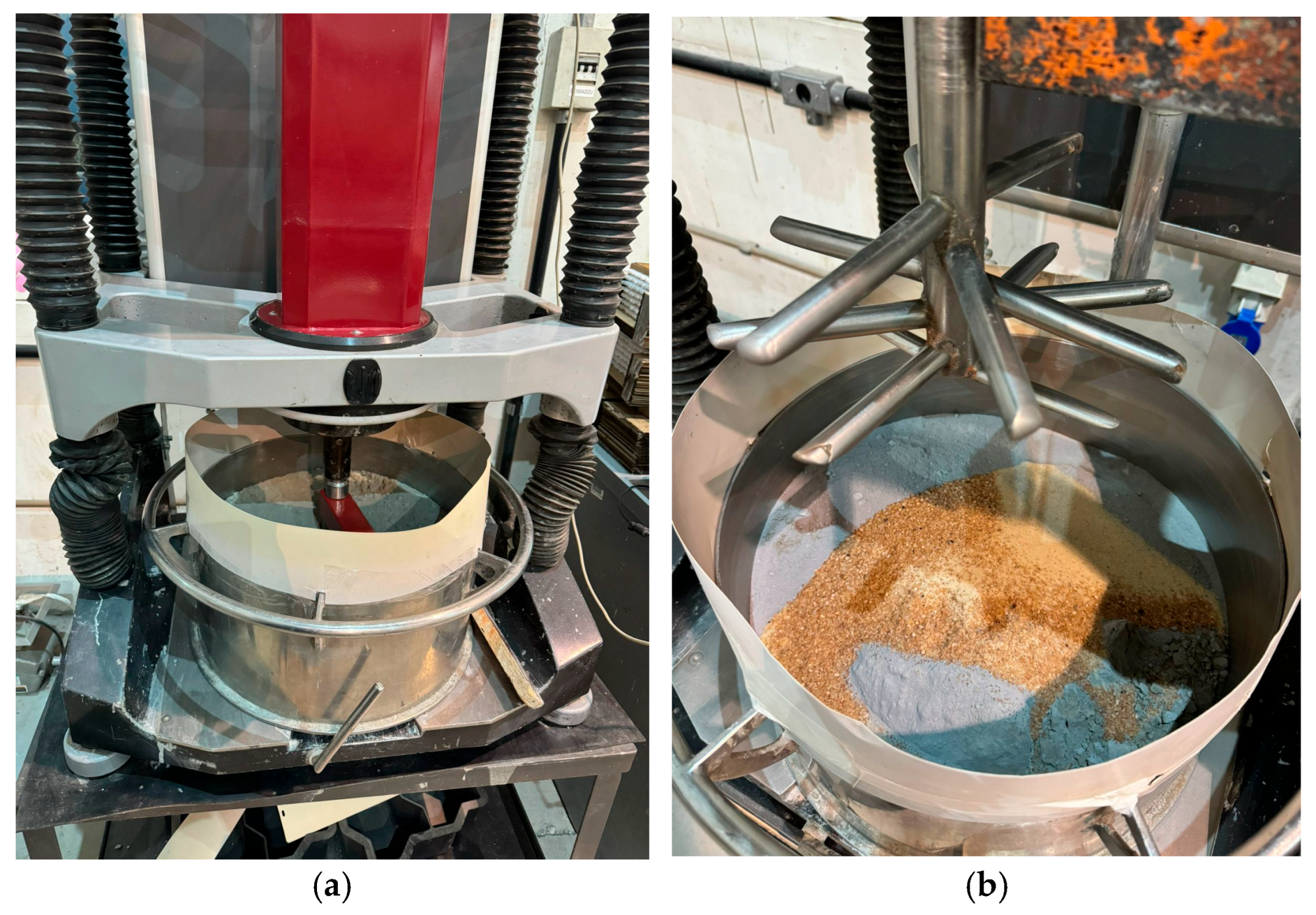
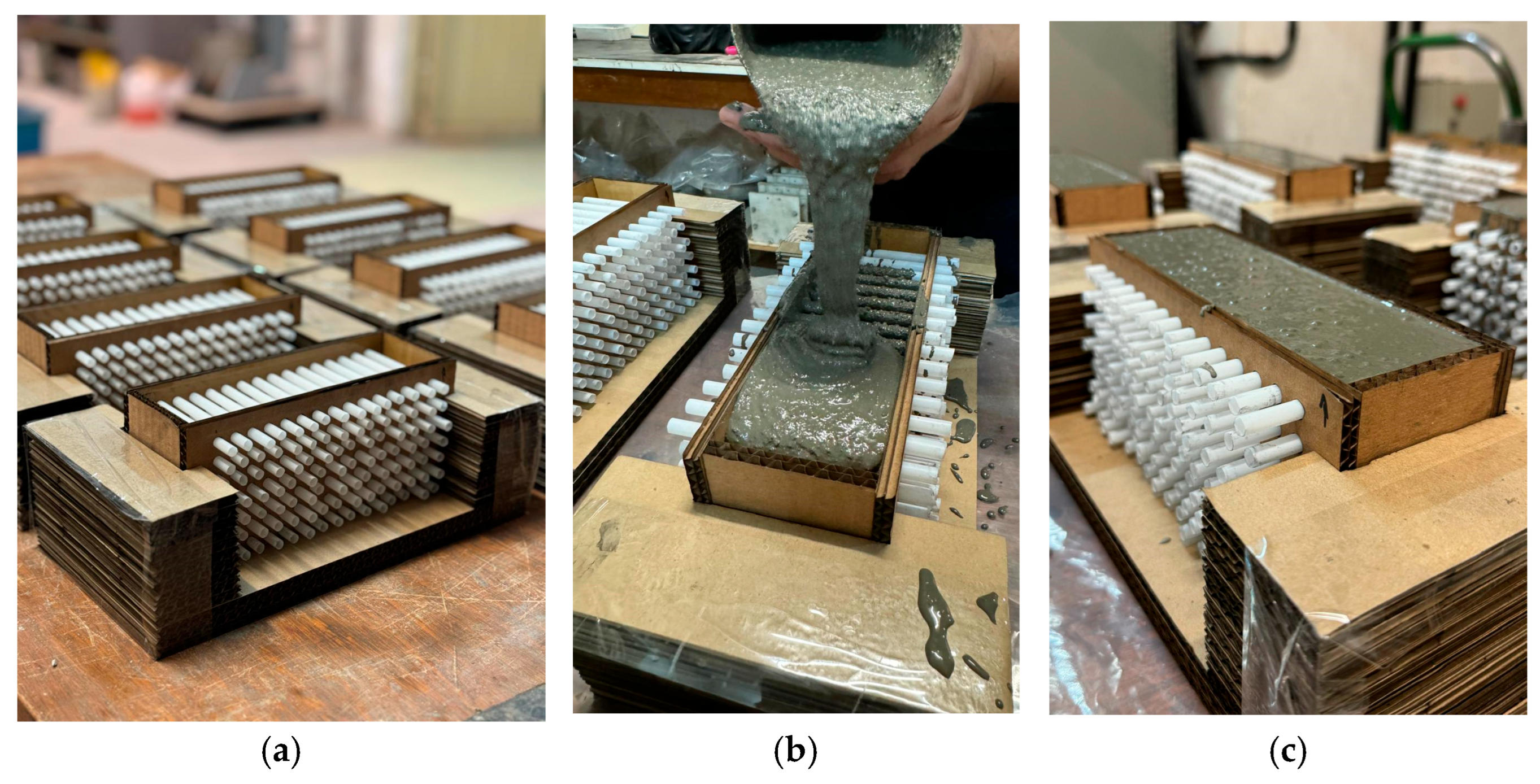


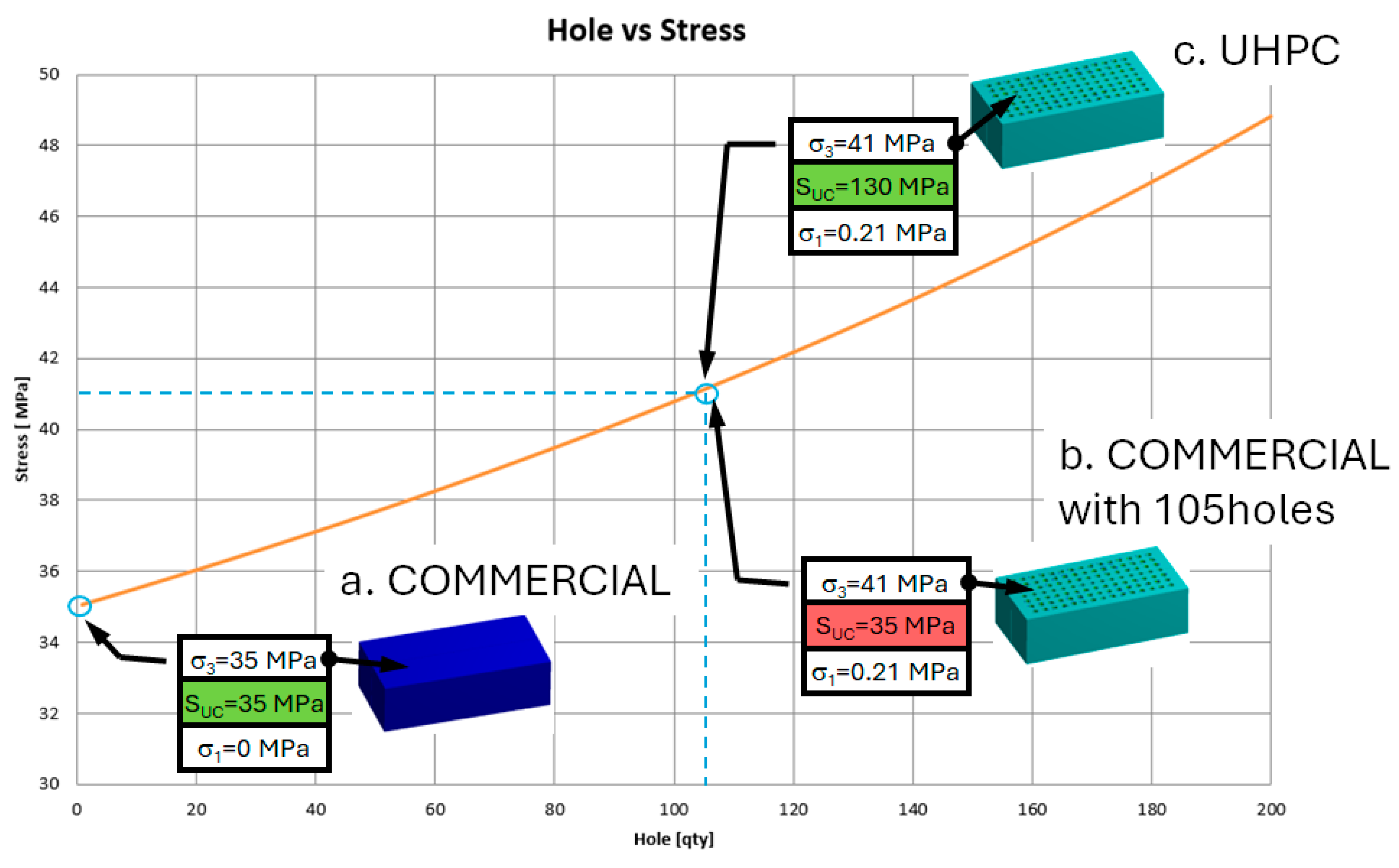

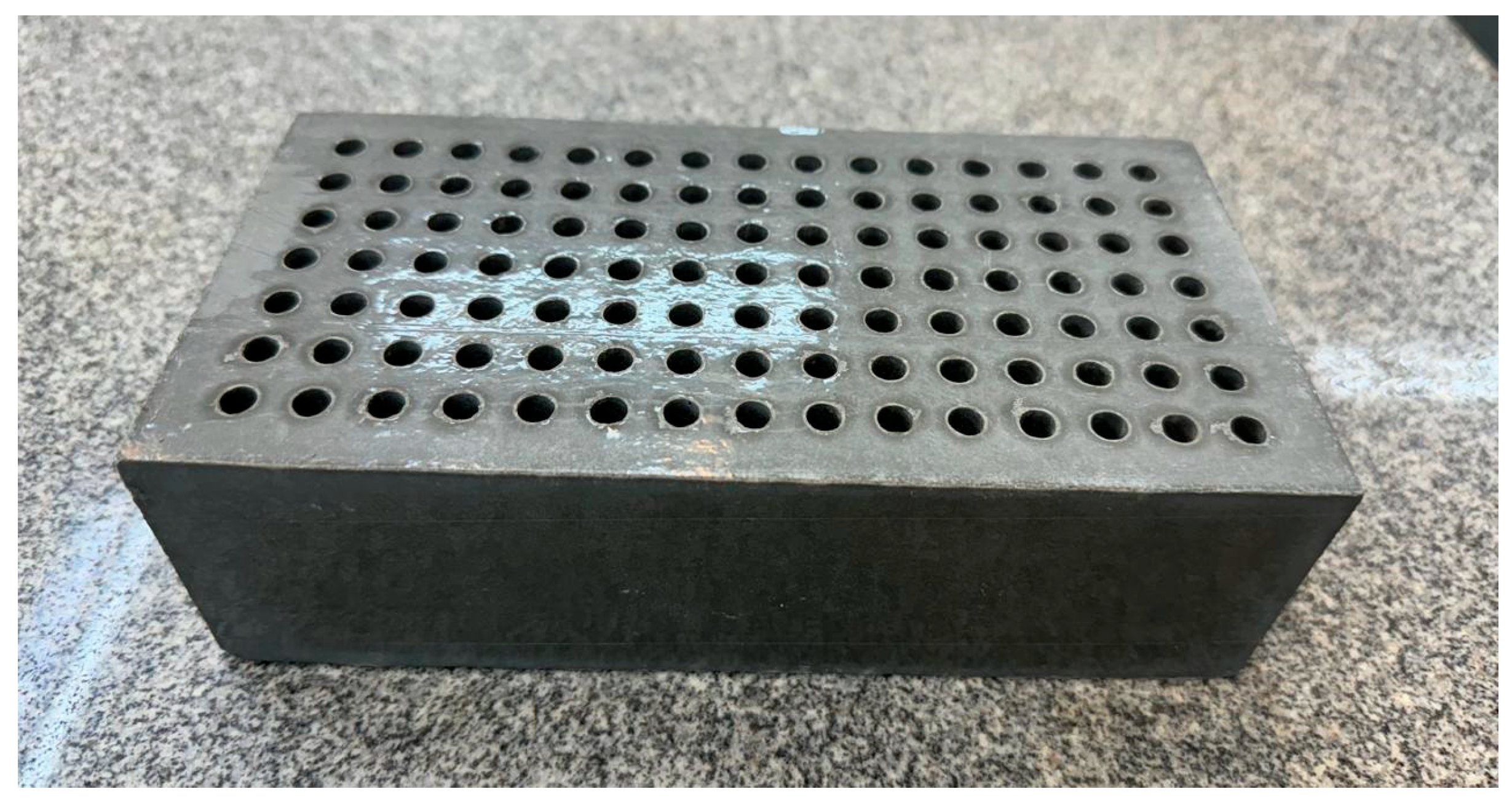

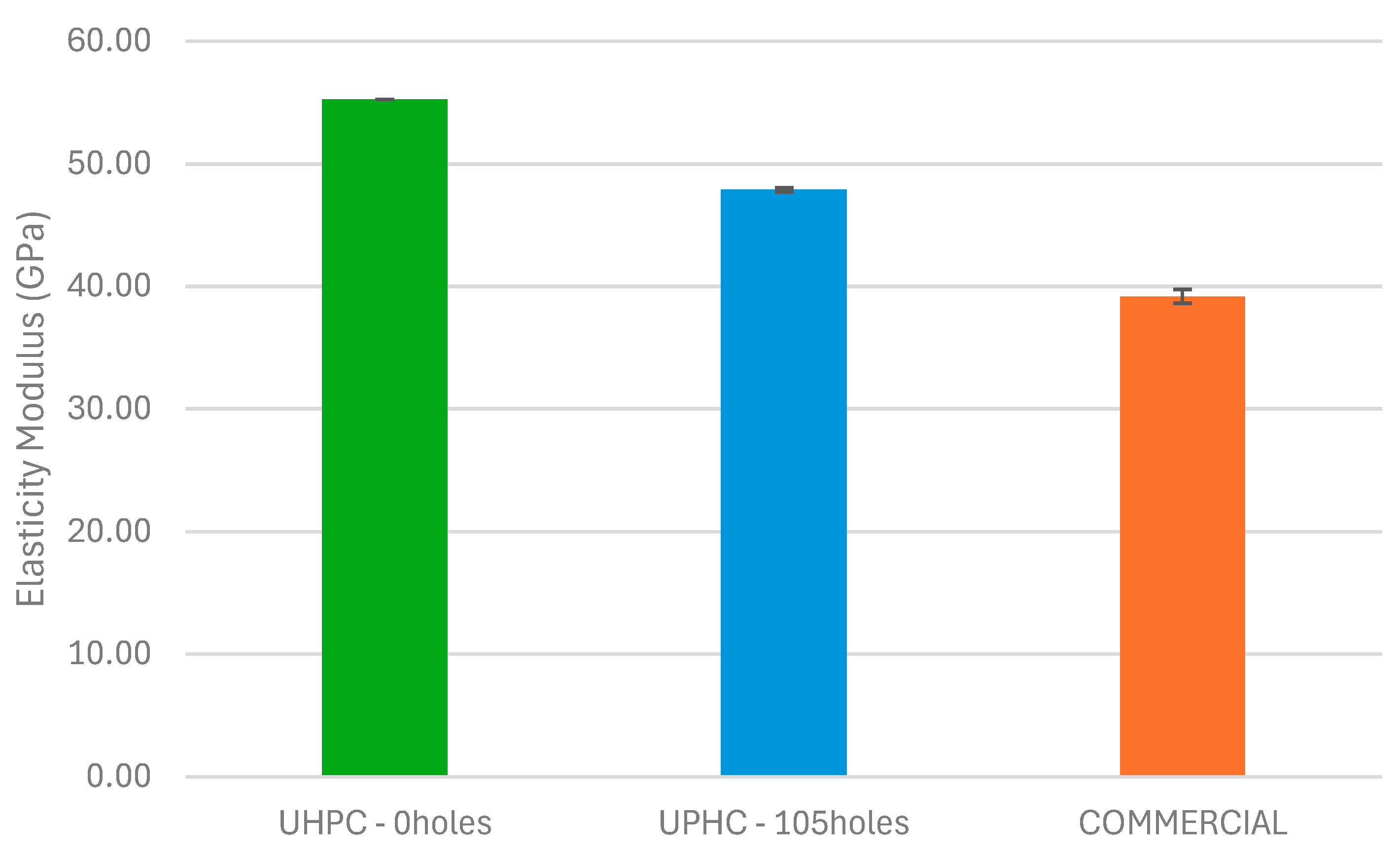
| Properties | Units | Steel Plate | COMMERCIAL | UHPC |
|---|---|---|---|---|
| Solid Density | kg/m3 | 7850 | 2300 | 2470 |
| Poisson’s ratio | 0.30 | 0.18 | 0.15 | |
| Young’s Modulus | MPa | 210 × 103 | 25 × 103 | 56 × 103 |
| Tensile Strength | MPa | 800 | 6.1 | 16 |
| Compressive Strength | MPa | 960 | 35 | 130 |
| Raw Material | D10 (μm) | D50 (μm) | D90 (μm) | SSA (g/cm3) | Density (g/cm3) |
|---|---|---|---|---|---|
| OPC | 2.81 | 9.46 | 26.76 | 1.26 | 3.09 |
| MC | 0.59 | 1.41 | 2.81 | 4.03 | 2.95 |
| SF | 0.196 | 0.301 | 0.435 | 23.7 | 2.19 |
| LF1 | 0.70 | 2.37 | 6.69 | 3.43 | 2.78 |
| LF5 | 1.41 | 7.95 | 18.92 | 1.03 | 2.78 |
| Sand_1 | 1000 | 1180 | 1700 | 0.02 | 2.67 |
| Sand_5 | 212 | 425 | 710 | 0.04 | 2.66 |
| Chemical Species | OPC (%) | MC (%) | SF (%) | LF (%) |
|---|---|---|---|---|
| SiO2 | 19.2 | 30.7 | 97.3 | 4.52 |
| Al2O3 | 4.94 | 9.79 | 0.30 | 0.11 |
| Fe2O3 | 2.97 | 0.86 | 0.10 | <0.10 |
| CaO | 60.8 | 42.2 | 0.40 | 48.4 |
| MgO | 0.67 | 5.66 | 0.20 | 5.89 |
| SO3 | 4.47 | 5.92 | 0.20 | <0.10 |
| Na2O | 0.15 | 0.45 | 0.20 | <0.10 |
| K2O | 0.70 | 0.60 | 0.30 | <0.10 |
| TiO2 | 0.25 | 0.66 | <0.10 | <0.10 |
| P2O5 | 0.27 | <0.10 | <0.10 | <0.10 |
| MnO | 0.09 | 0.23 | <0.10 | <0.10 |
| SrO | 0.27 | 0.07 | <0.10 | <0.10 |
| L.O.I | 3.87 | 3.07 | 0.60 | 41.0 |
| Raw-Materials | Consumption (kg/m3) |
|---|---|
| OPC | 351 |
| MC | 91 |
| SF | 44 |
| LF1 | 409 |
| LF5 | 162 |
| Sand-1 | 498 |
| Sand-2 | 762 |
| Water | 153 |
| w/s | 0.06 |
| w/b | 0.31 |
Disclaimer/Publisher’s Note: The statements, opinions and data contained in all publications are solely those of the individual author(s) and contributor(s) and not of MDPI and/or the editor(s). MDPI and/or the editor(s) disclaim responsibility for any injury to people or property resulting from any ideas, methods, instructions or products referred to in the content. |
© 2025 by the authors. Licensee MDPI, Basel, Switzerland. This article is an open access article distributed under the terms and conditions of the Creative Commons Attribution (CC BY) license (https://creativecommons.org/licenses/by/4.0/).
Share and Cite
Gadler, F.; Mesquita, J.A.F.S.d.; Oliveira, F.H.A.; Bernucci, L.L.B.; Pileggi, R.G.; Silva, E.C.N.; Prado, D.S. Innovative Use of UHPC and Topology Optimization in Permeable Interlocking Pavers: Advancing Sustainable Pavement Solutions. Sustainability 2025, 17, 6039. https://doi.org/10.3390/su17136039
Gadler F, Mesquita JAFSd, Oliveira FHA, Bernucci LLB, Pileggi RG, Silva ECN, Prado DS. Innovative Use of UHPC and Topology Optimization in Permeable Interlocking Pavers: Advancing Sustainable Pavement Solutions. Sustainability. 2025; 17(13):6039. https://doi.org/10.3390/su17136039
Chicago/Turabian StyleGadler, Fernanda, José Augusto Ferreira Sales de Mesquita, Francisco Helio Alencar Oliveira, Liedi Legi Bariani Bernucci, Rafael Giuliano Pileggi, Emilio Carlos Nelli Silva, and Diego Silva Prado. 2025. "Innovative Use of UHPC and Topology Optimization in Permeable Interlocking Pavers: Advancing Sustainable Pavement Solutions" Sustainability 17, no. 13: 6039. https://doi.org/10.3390/su17136039
APA StyleGadler, F., Mesquita, J. A. F. S. d., Oliveira, F. H. A., Bernucci, L. L. B., Pileggi, R. G., Silva, E. C. N., & Prado, D. S. (2025). Innovative Use of UHPC and Topology Optimization in Permeable Interlocking Pavers: Advancing Sustainable Pavement Solutions. Sustainability, 17(13), 6039. https://doi.org/10.3390/su17136039






